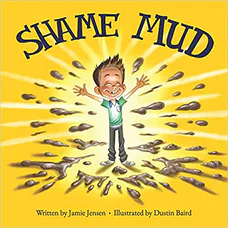Shame Mud
Written by Jamie Jensen
Illustrated by Dustin Baird
41 pages
•
Published 2021 (independently published)

Recommended Age Range: Kindergarten through 3rd grade.
Publisher's Summary:
Shame Mud is a therapist-approved book in verse designed to help kids process shame with the support of a trusted adult, and to notice the effects of shame on the body.

Dr. Annie's Takeaways
Recommended for: Children who are burdened by self-criticism after they make mistakes will likely benefit from this story’s description of shame and the reminder that mistakes don’t define their self-worth. It provides a lovely model of a mother joining her child in his emotional pain and then helping him to gently challenge his shaming self-talk.
Would a child like it? A young child who has their own experience with “shame mud” would probably connect with this story, even if it’s not necessarily a story that a child would really love. It leads well into a snuggle and provides a script of sorts to challenge shame thoughts– “Is it so wrong to fall? Is it so wrong to fail a quiz? It’s fine to miss a ball.”
Evidence-Based Practices:
Cognitive restructuring
Tone: Warm, sentimental
Story Quality: This book uses rhyming verse to share the story of a boy, Bill, who is weighed down by shame (pictured as mud) after making mistakes throughout his day. His mother helps him realize that there’s nothing wrong with making mistakes and that mistakes don’t “change [his] worth one bit.” The story is a bit generic, and it has a few lines that made me roll my eyes (e.g., “‘That does sound hard,’ sweet momma said. Her heart was overflowing”) but there are some genuinely lovely moments in the book when Bill opens up to his mother about his shame.
Illustrations: Cheerful, brightly colored cartoons. Bill’s shame is pictured as mud that gets heavier and heavier until he opens up to his mother about it.
Representation: Bill is a White boy and he has a White mother. Most of his friends are White boys. His baseball teammates are all boys but racially diverse, and he has diverse classmates.
Psychological Practices: This book describes the feeling of shame with a recurring verse, “His cheeks were warm, his chest felt tight, His feet were dragging slow. He could not bring his head up high. His heart felt awfully low.” The most effective moments are when Bill opens up to his mother and she sits with him and his feelings– “They did not run, or rush, or force. They took some time for healing.” Bill’s mother then reminds him that there’s nothing wrong with making mistakes and that his mistakes don’t define his worth. The book ends with an effective “expectancy violation
”–Bill’s teammates express their support despite his mistake, which went against his expectation that they would reject him, and this helps him to accept that his mistakes don’t mean he’s bad.
Concerns: Bill’s shame was reduced by convincing him that his mistakes didn’t change others’ opinions about him (i.e., his teammates were not actually mad at him, his friend still wanted to see him). This is often effective, but I would have also appreciated a nod to the fact that sometimes we need to apologize or right a wrong before moving on, and other times others are upset with us but that still doesn’t make us bad.
